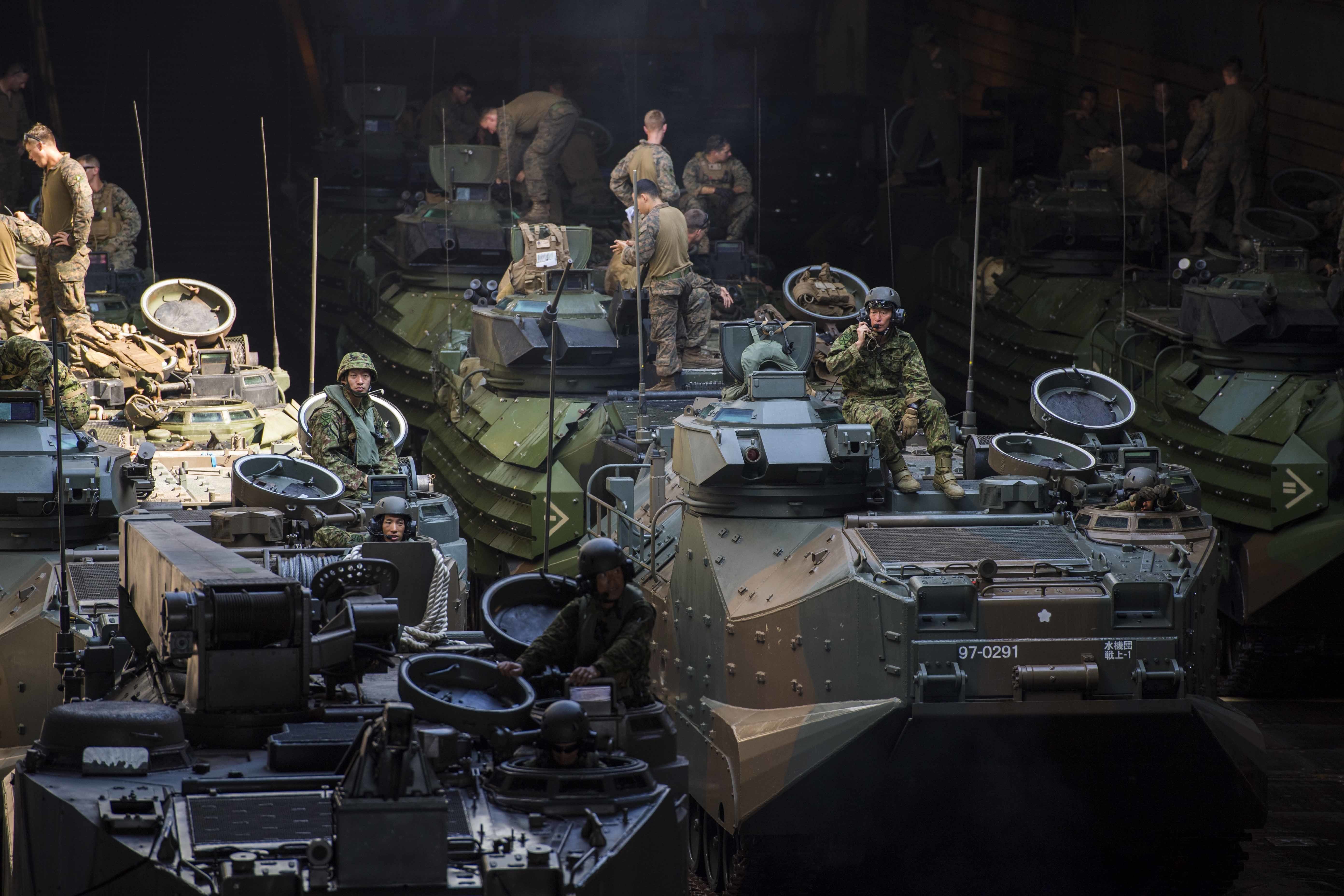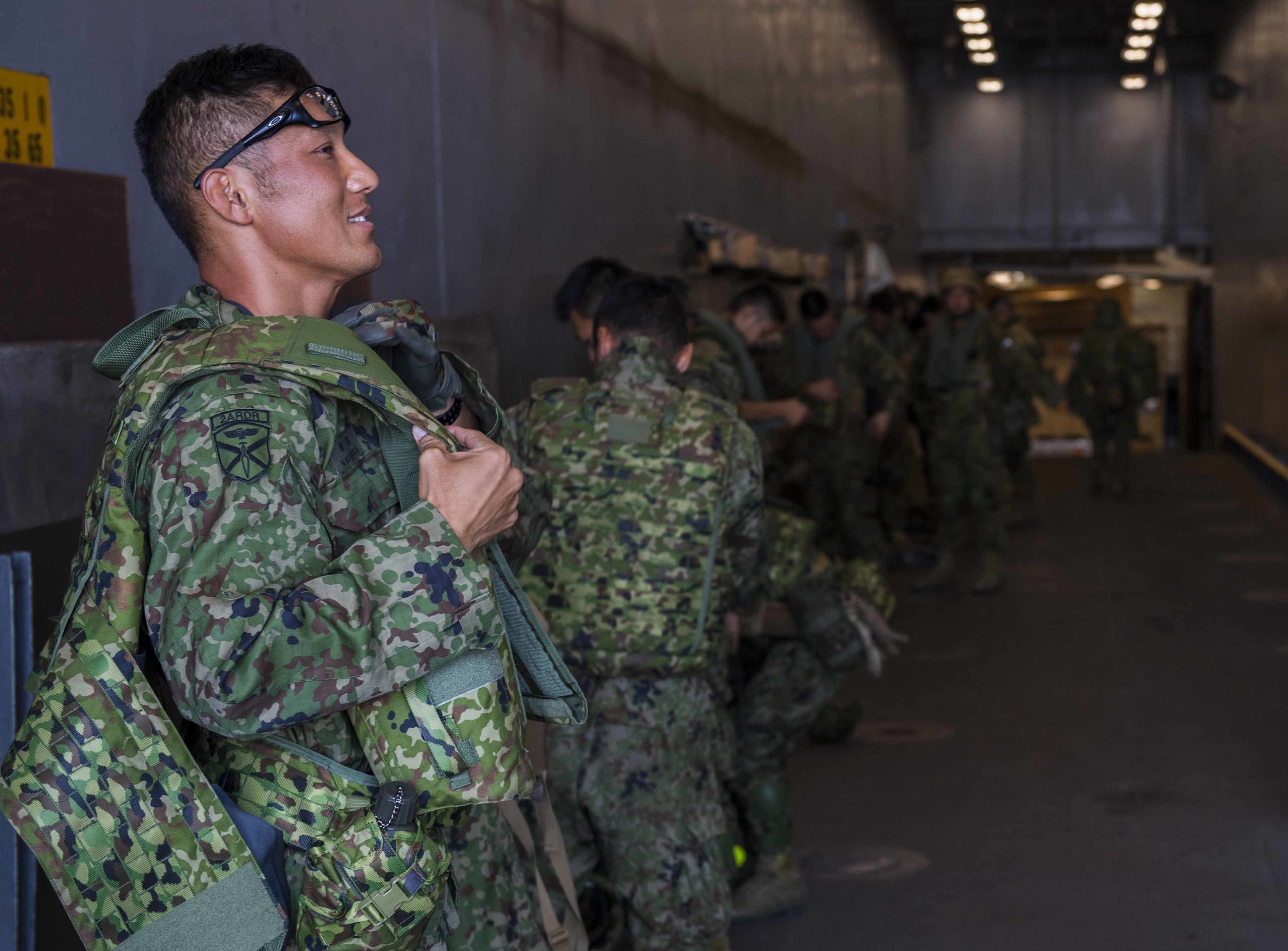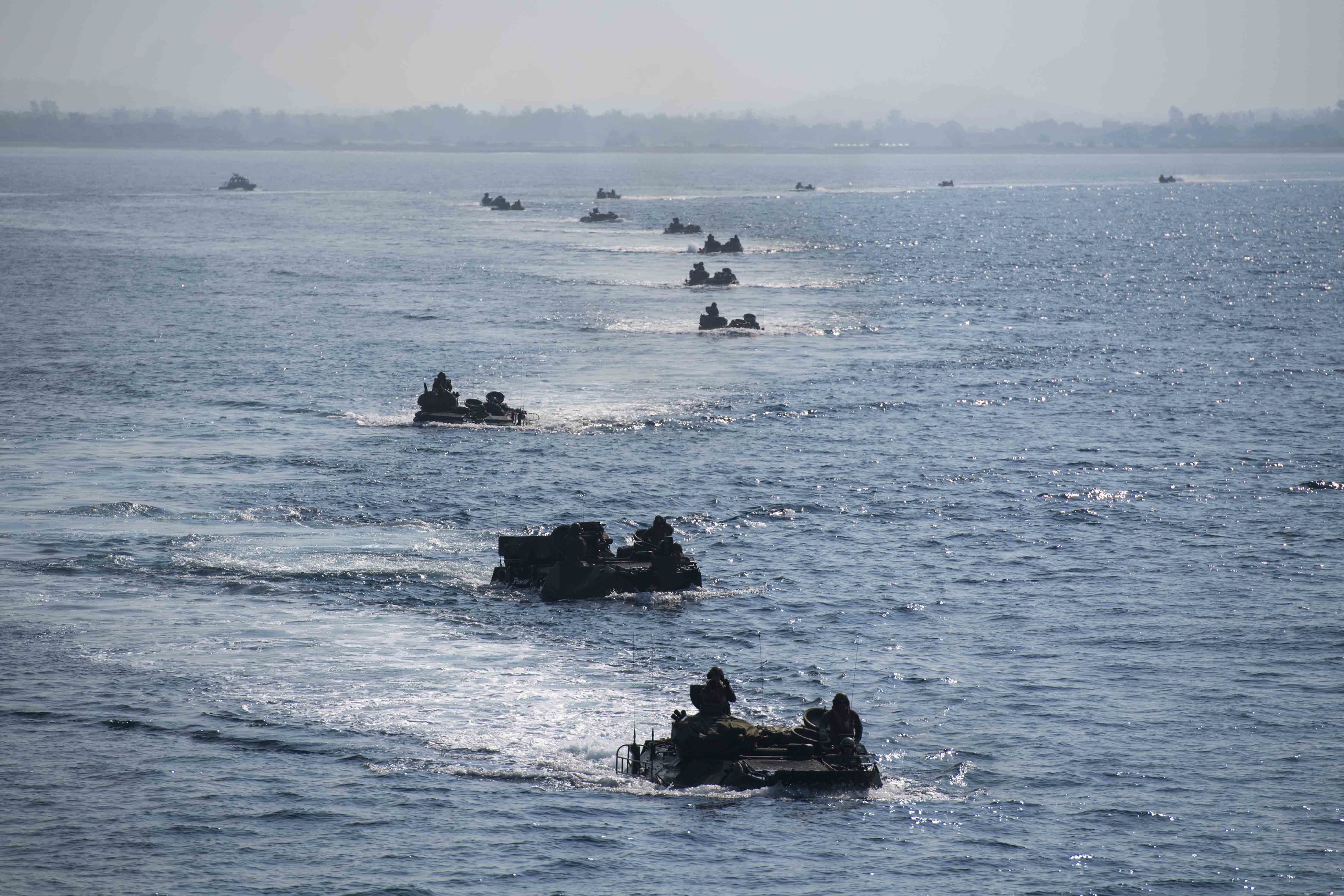
It was no ordinary beach assault when troops took off on amphibious assault vehicles from a U.S. Navy ship and raced ashore in a training exercise with U.S. Marines.
That’s because the landing onto a Philippine beach by Japanese soldiers from their AAV-P7/A1 amtracs marked a significant step in bolstering Japan’s capabilities of its nascent Amphibious Rapid Deployment Brigade.
The amphibious unit, comprised of soldiers with Japan’s Ground Self Defense Force, joined with Marines of the 31st Marine Expeditionary Unit aboard dock landing ship USS Ashland (LSD-48) for the training alongside Philippine military forces during the bilateral exercise Kamandag, or “Kaagapay Ng Mga Mandirigma Ng Dagat,” along the Philippine Sea northwest of Manila.
The 10-day exercise between the U.S. and Philippines kicked off Oct. 2 and is focused on humanitarian and disaster response, amphibious operations and counter-terrorism training. The exercise also includes members of 7th Fleet, 3rd Marine Expeditionary Brigade, along with the Philippine Marine Corps, Philippine Navy and Philippine Air Force. Japan doesn’t allow its defense forces to participate in offensive, combat type training, although the prime minister has supported revising its policy and pacific constitution.
The ARDB formed in March under the JGSDF’s Western Army with a mission of rapid deployment for contingencies, including potential threats to and attacks against Japan’s many remote islands. “Security units will be positioned on Amami Oshima, Miyako Island and Ishigaki Island,” according to an Aug. 27 Japan Ministry of Defense overview on Japan’s security environment in the Asia-Pacific region. Those are islands southwest and northwest of Okinawa in the Ryukyu Islands chain that stretches between the Pacific and the East China Sea.
During the amphibious landing exercise, soldiers with the ARDB, which officially stood up in late March, soldiers came ashore in AAVs in a simulated mass-casualty operation. “This exercise was a good opportunity to enhance the capability to respond quickly to HADR, humanitarian assistance and disaster relief, missions,” JGSDF Lt. Col. Yoshiji Aoyama, the lead Japanese exercise planner for the training, said in a Marine Corps news story. “It provided us the opportunity to strengthen relationships with U.S. and Philippine forces.”

The amphibious landing also marked the first time that Japan has operated its current, small fleet of AAVs in a foreign country. (ARDB soldiers trained with Marine Corps amtracs during training earlier this year at Camp Pendleton, Calif.) Japan is growing its fleet with the new AAV-P7/A1 through a 2016 contract with manufacturer BAE Systems for 30 vehicles. No ship with Japan’s Maritime Self Defense Force joined in Kamandag, but a commercial ship hauled the AAVs to the region for the exercise.
“This is a milestone achievement and a significant step forward in capability development for Japan’s newly established amphibious force,” Rear Adm. Brad Cooper, commander of Amphibious Force 7th Fleet (Task Force 76), said in a Navy statement. “The JGSDF and JMSDF (Japan Maritime Self Defense Force) have made enormous strides in their amphibious capability since the establishment of the ARDB just six months ago.”
The presence of a small force of JGSDF’s “sea soldiers” along with Japan and 31st MEU’s AAVs provided an interesting third wheel during the bilateral training designed to improve interoperability and strengthen partnerships among the forces. The Philippine Navy and its Philippine Marine Ready Force also are adopting the amtracs. The Philippine landing platform dock ship BRP Davao del Sur (LD-6002) joined Ashland for the exercise.
“This is another step forward in working alongside the Philippine Marine Corps and the Philippine Navy as they advance their amphibious capability,” Lt. Col. Michael K. Chankij, the lead U.S. exercise planner, said in the Marine Corps news story, noting the exercise follows AAV shipboard and amphibious assault training held last year with the Philippine Navy’s BRP Tarlac (LD-601).
“Amphibious operations are a core competency that shapes who we are as Marines,” said Lt. Col. Henry R. Espinoza, the Philippine Marine Ready Force’s chief of staff. “We are anticipating the arrival of our first fleet of AAVs next year. The training we received from the U.S. Marines provides the Filipino AAV operators knowledge on how these amphibious vehicles operate, which is crucial to how our own AAV operators will effectively conduct future operations.”

“Training with U.S. Marines and the JGSDF is crucial in fostering camaraderie, friendship and the exchange of ideas,” Espinosa said, adding the Filipino force expects to use their own, new AAVs for the next iteration of Kamandag in 2019.
Japan ARDB’s training with U.S. and Philippine forces – and in the Philippines – is seen as a big step toward greater participation by Japan forces with other allies and partners in the region.
“It’s good to see this,” Grant Newsham, a senior fellow with the Japan Forum for Strategic Studies, told USNI News. The trilateral interaction “builds goodwill and confidence in both directions.”
The exercise is another critical step toward building the ARDB as a capable, credible force, Newsham said. The ARDB “is just getting started so they naturally need a lot more work and practice. There’s also a need for the ARDB and MSDF to regularize their relationship,” much like the 31st MEU and 7th Fleet.
And that, he said, means ensuring ships “are available on a regular rotation, not just when ‘timing works out.’” It wasn’t a Japanese Navy ship but commercial vessels that brought Japan’s AAVs to the exercise. “(It) would have been good if they came on MSDF LST – but Japanese Navy only has a few of them,” he noted. “But for now, the chance to operate aboard the USS Ashland (with Americans close at hand to ‘coach’) is a good thing and advantageous for ARDB.”
The AAVs will be important vehicles for the range of missions Japan currently expects the amphibious force will get, and recent disasters have proved its life-changing need and benefits even in peacetime. “It’s a useful piece of equipment to have in the ‘tool kit’ when one builds an amphibious capability,” Newsham said. “And in Japan’s case, AAVs are especially useful for HA/DR operations.”

If the Ground Self Defense Force had AAVs in the devastating 2011 earthquake and tsunami, Newsham said, along with the maritime forces “they’d have saved hundred if not thousands of lives. They didn’t have them so people who might have been saved froze to death instead. Thus, having AAVs will be helpful for both domestic and overseas HA/DR and disaster response operations.”
That prospect is a reminder, too, that as the ARDB continues to hone its capabilities and build skills within the force, it needs to train with not just Japan’s maritime force but jointly, with more of the Ground Self Defense Force and, particularly, the Air Self Defense Force. But that’s been severely lacking, Newsham said.
“In order to use an AAV properly, the GSDF and MSDF would be forced to cooperate,” he said. “So it served as a ‘forcing function’ to address the JSDF’s fundamental weakness – the sheer inability of the JSDF services to cooperate and conduct ‘joint’ operations.” The air piece can’t be forgotten, either, including GSDF helicopters. “Maybe someday in the next 100 years the ASDF might deign to get involved with amphibious operations, rather than insisting on flying around at 30,000 feet looking for a dogfight,” he added. “Particularly in the case of amphibious ops, if you don’t practice you don’t improve. Newsham said. So “anytime you can practice taking AAVs on and off an amphibious ship, it’s a good thing. The Japanese have only had AAVs for a couple years – and there are never enough opportunities to practice. Employing the GSDF AAVs is different and more complex than putting a platoon of (soldiers) on a U.S. ship somewhere and going ashore in Marine AAVs or helicopters.”

The rapid growth ARDB’s progress on the ARDB has “Japan’s amphibious force will progress faster or slower depending on the extent to which the U.S. Marines and U.S. Navy make the effort to assist,” he said. Benefits also will come with any training with Australia or British Royal Marines, as well as continuing coaching by their U.S. counterparts and in different, foreign environments that “is rare for GSDF,” he added. “This builds Japanese confidence – and that’s an important part of capability development, and future operations. It also gets increases American confidence in the Japanese – and that too has long been missing in the Marine-GSDF relationship in particular.”





